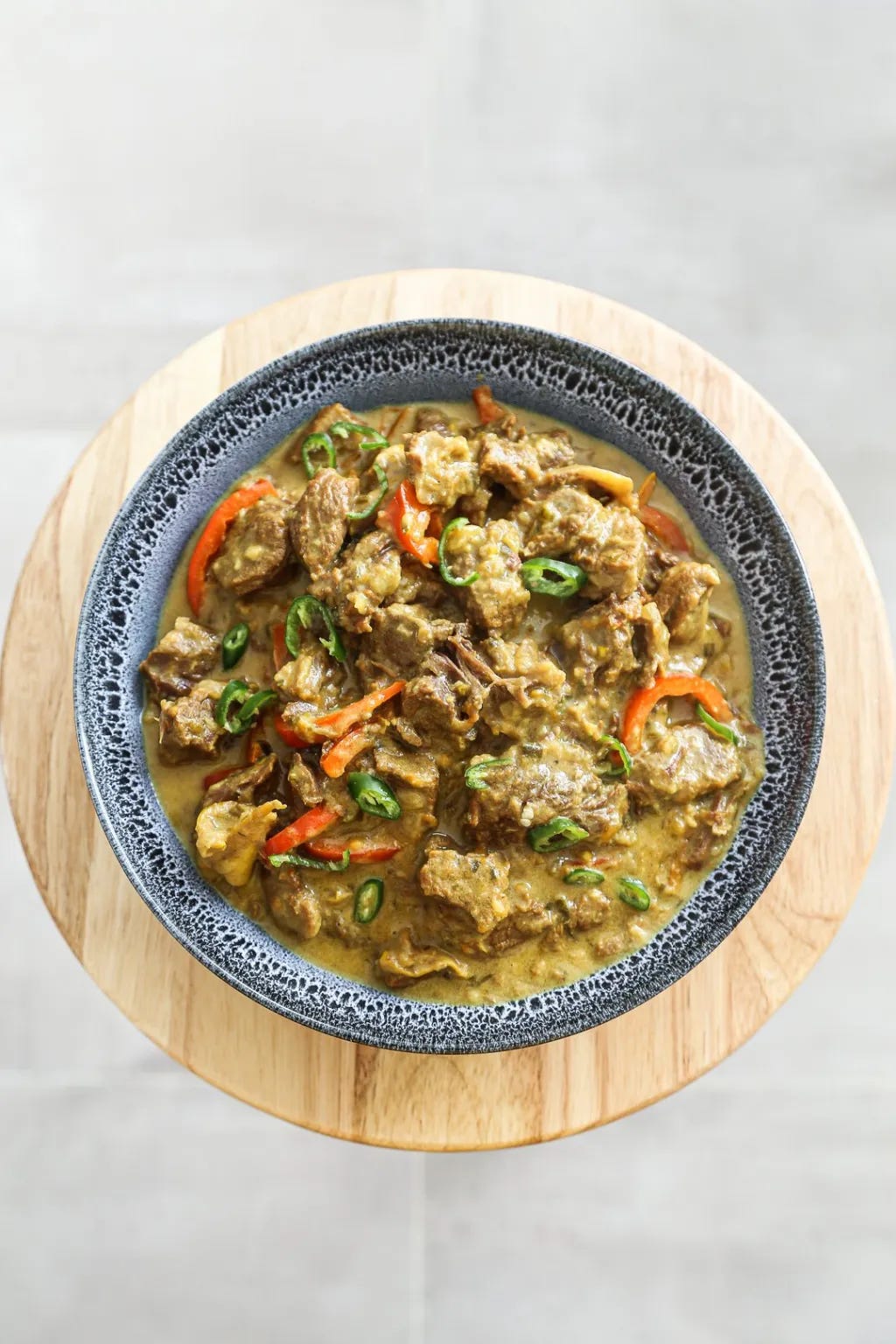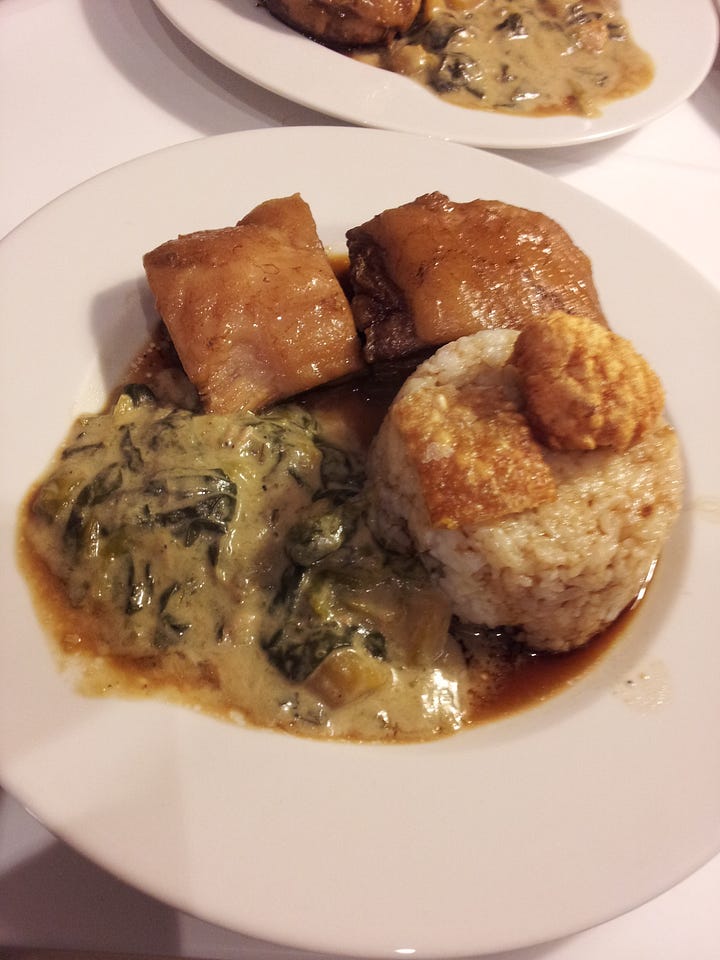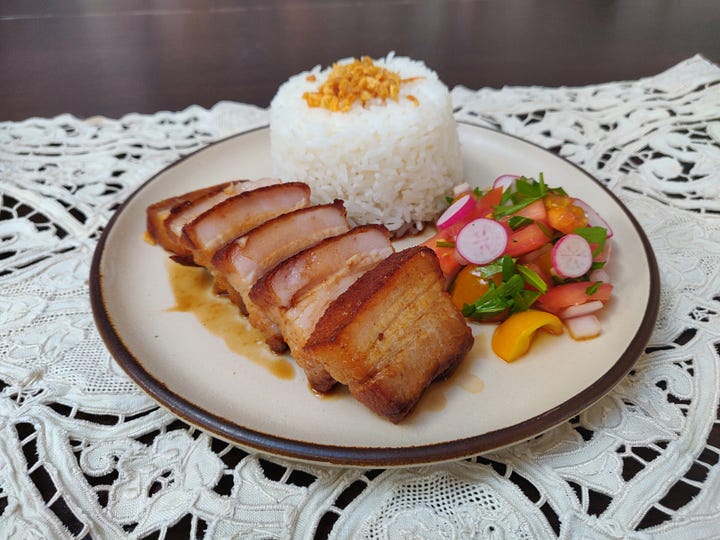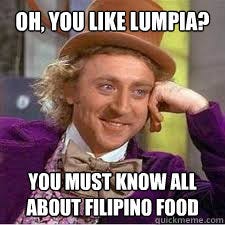Knowing me, Knowing You, Knowing Filipino Food
Celebrating - and learning about - our food during Filipino Food Month
The other day, I was idly chatting to my wife about traditional Filipino clothing (as you do) whilst doing some Adobros admin work. She had seen a post on social media by this Filipino jewellery company (Cambio & Co. - do check them out, they have some nice things which the wife certainly appreciated me buying for her…!), discussing and showcasing various traditional attire beyond the colonial era Maria Clara gown/traje de mestizo that we all know and love.
You see, they had mentioned the sinina, a pre-colonial women’s dress from the Visayas (you can see it in the illustration below); my wife, a Cebuano Visayan, was excited to see it referenced and wanted to share it with me.
Visayan noble couple, with the woman wearing sinina. Illustration from the Boxer Codex (c. 1590s)
Not knowing what it was, I proceeded to google sinina and… came across a dish, also called sinina, from Maguindanao on the southern island of Mindanao. It’s beef or goat braised with vegetables and spicy palapa paste in coconut milk, and served during festivities. Like a cross between kaldereta and rendang, the recipe suggests, which sounds like the match made in heaven I never knew I needed until now. Unsurprisingly, I found this sinina to be a little more interesting than the other sinina; perhaps a good candidate for a cooking video in the future!

Aside from its seeming deliciousness, what struck me was how, despite having devoted more time in recent years to looking at the various regional cuisines of the Philippines (outside of the more Luzon-inspired dishes I grew up with), sinina still came as a complete and pleasant surprise to me and my wife. But I would hazard that many of you reading this would not have heard of sinina either; the cuisine of Maguindanao, along with the other Muslim Moro cuisines of Mindanao, still remains a mystery to the vast majority of Filipinos, let alone everyone else.
What this really emphasises though is that for me, and perhaps many of us, there is still so much Filipino food out there that we just don’t know about. Either because it’s from a different family, a different region, a different religion, perhaps has fallen out of fashion, or perhaps because we left the Philippines so long ago or never grew up there and are divorced from current trends. It’s certainly a humbling thought, but one which I think is quite apt for Filipino Food Month.
**********
Since 2018, April has been designated by the Philippine government as Buwan ng Kalutong Pilipino. Cue lots of mentions of adobo, sinigang, lumpia, pancit, kare kare - all the big hitters of Filipino food that everyone knows. But that’s not the totality of Filipino food, is it?
Growing up outside of the Philippines, my own view of Filipino food has very much been informed by my mother’s own background: growing up in the cosmopolitan and economically and culturally powerful capital Manila, part of the Tagalog cultural sphere that is dominant in the Philippines. What she fed and taught me was further shaped by where we lived: in Hong Kong, Singapore and the UK. It was only when I met my wife, Cebuana from Cebu, part of the Visayan cultural sphere that has often clashed with ‘imperial Manila’, that I started to realise how little I knew about Filipino food in the rest of the country.
It also made me start to interrogate the idea of what we mean by Filipino food, Filipino cuisine. There are certainly commonalities across the country - dishes like adobo, sinigang and kinilaw, or variants of them, can be found just about everywhere, demonstrating the strong love for the sour that defines tastes in the archipelago - but there also a lot of regional and cultural differences, and definitely a lot of dishes that are popular in one region but are virtually unknown in the others.
Look at adobo. Considered by many to be the unofficial national dish of the Philippines, it is usually described as a cooking method utilising vinegar, soy sauce, garlic, black pepper and bay leaves. That’s the type of adobo I grew up with, and when you see adobo flavourings in snacks, that’s what you usually get. But this view of adobo is quite limited: there are many different types of adobo. Adobong puti, adobong pula, adobong dilaw, adobong pina-uga, adobong pusit; how many of these have you heard of?
Different types of meats, seafoods and vegetables are used. The vinegars used are numerous. Many do not make use of soy sauce; many add different spices or herbs to the mix; some add coconut milk; some are dry, some are quite wet. The Adobo Cookbook, compiled by Reynaldo Gamboa Alejandro and self-proclaimed ‘Adobo Queen’ Nancy Reyes-Lumen, has nearly 200 (!) adobo recipes. The one common denominator across all of these varieties is the usage of vinegar as the cooking element, which is absolutely non-negotiable (side note: recently in a bookstore, I flipped through the debut pan-Asian cookbook of a self-proclaimed ‘expert’ in Asian cuisine here in the UK; their adobo recipe treats the vinegar almost as an afterthought, added in right at the end, which to me suggests they don’t really understand adobo)
Adobo is a common Filipino dish, but in reality it is also a multiplicity of dishes. And I think that’s a great way of looking at Filipino food in general. These days, I prefer to talk more about Filipino cuisines in the plural, to reflect the commonalities and the differences that both unite and divide us.
After all, if other countries like Italy and China can talk about their regional cuisines in this fashion, why can’t the Philippines?
**********
Discovering more about the various Filipino cuisines is a key part of Filipino Food Month. An initiative of the Philippine Culinary Heritage Movement, the organisation founded by chef Jam Melchor, Filipino Food Month’s goal is to help “appreciate, preserve, promote, and ensure the transmission to future generations of our vast culinary traditions and treasures”.
Appreciate, preserve, promote, and transmit. It’s a powerful mission statement. Appreciation is not just about the enjoyment of the food (which I am fairly adept at, I think it’s fair to say); it’s also about really understanding the whats, hows and whys of the various foods we enjoy. For me, this should cover everything: from the elaborate fiesta foods like lechon, kaldereta, mechado and relleno; to the street foods long-considered to be ‘icky’ by foreigners, like balut and isaw; and the more modern additions to our repertoire like spam, hot dog, and Filipino spaghetti.
Once we appreciate why these foods are a part of Filipino culture and are enjoyed in kitchens and eateries up and down the country and in the diaspora, then we can understand why we would want (or even not want!) to preserve, promote and transmit them to the next generation.
It’s really about expanding our knowledge of what Filipino food and cuisine is - for me, that includes looking beyond what I grew up and am familiar with. But it’s also what we do with that knowledge that interests me - receiving it, digesting it, and passing it on. That is where things can get interesting and complex.
As an example: in my family, I first experienced adobo (usually chicken) as a kid, eating what my mum would cook for our dinners. At some point, my brother and I asked to be taught how to cook it; we were given rough guidelines, but no specific recipe. Following those guidelines, we cooked adobo for ourselves, adapting it bit by bit each time to take into account our mood on the day, changing tastes as we grew up, and availability of ingredients as we moved to the UK. Slowly but surely, the adobo we grew up with, also grew with us. And now Pork Belly Adobo, braised in vinegar and soy sauce, pressed for a few hours and then finished under the grill, is one of the hits for The Adobros.
I’m sure that when I teach my little girl how to make it, her relationship with adobo will develop and grow too. Our family adobo has been preserved and transmitted, but it has changed as a result of that process.


What I’m getting at here is that the knowledge that builds up Filipino food, what Filipino Food Month is celebrating and asking us to learn about, is not static or immutable, or even in one form. It is always changing because it is being shaped by the many different people who are experiencing it in their own ways: people who prefer one thing over another; who develop new techniques and processes; who edit and annotate recipes; who incorporate new ingredients or influences; or who just approach and understand a dish in their own way.
It may make it seem like it’s difficult to preserve something if it’s always changing and fracturing into various forms. But arguably the change it is undergoing is the very thing that is preserving it - the dish evolves to stay relevant and very much a part of peoples’ lives. In comparison, dishes that refuse to evolve, that have frozen themselves at a certain point at time, are more likely to disappear. I always think of these two articles written about pie and mash, what was once a fixture of many a Londoner’s diet: pie and mash, in the words of one of its purveyors, “hasn’t altered. It won’t alter”, and unsurprisingly, is fading away from the culinary landscape of London.
I’m racking my brains to think of a Filipino dish that is similarly disappearing, because it refuses to be changed. Off the top of my head, I can’t really, and I think that’s likely because most of what we love and enjoy has changed over time (if you can think of any, let me know in the comments below!). Reading through the work of the food historian Felice Prudente Santa Maria, who has researched old recipe books, travel guides and other documentary evidence, you can sort of see this: there are many recognisable dish names, but what they actually are have shifted over time. An ingredient or two changed here and there, something else added at another time; adapted to changing tastes, and made more personal.
Which makes the multiplicity of Filipino cuisines even more fascinating. We have the national, regional, and the personal level. In his cookbook, Also Filipino, subtitled ‘75 regional dishes I never had growing up’, Angelo Comsti describes it thus:
I came to realize how personal Filipino cuisine is. The way my dad prepared his adobo, which came with tausi and chicken liver, was differnt from our neighbor’s, whic had twice-cooked shredded meat. As I traveled around the country, I also discovered how regional it is. When I saw how the adobo of my childhood could have slight alterations from household to household, for turmeric to be added in the Batangas version or soy sauce to be omitted from the mix, like the one in Pampanga, it came as a surprise and delight.
It’s a reminder that food is inextricably linked with people, and ultimately their culture. And we have bags of both in the Philippines.
So this Filipino Food Month, aside from going out and supporting your local Filipino food business, how might you go about learning about the vastness of the many Filipino cuisines? Like Comsti, you could “knock on people’s doors, hang out in carinderias or street-side eateries, strike up a conversation with strangers I met in restuarants, enter private kitchens… [armed with] a lot of gall and a bottomless-pit appetite”. Or, you could check out the following people/resources on social media from the comfort of your home:
Exploring Filipino Kitchens - Nastasha Alli, a Filipino-Canadian, runs a podcast covering various Filipino food topics. She is currently living my dream by travelling and eating her way around the Philippines
Lokalpedia - a beautiful and eye-opening visual project by John Sherwin Felix highlighting a range of Filipino ingredients, particularly those that are hyper-local
Felice Prudente Santa Maria - renowned food historian who has access to an astounding archive of various historical food documents. She also regularly shares details about events, many online, that you can sign up for
KainCon - the delightfully-named KainCon (kain translating to rice) is the annual academic-minded conference of Filipino Food Month
Meryenda - the newsletter of Jessica Hernandez and Cassandra Balbas, two 2nd generation Filipino-Americans exploring Filipino food and culture from a diaspora perspective. Jessica has recently moved to the Philippines, giving her the opportunity to really get in-depth on her subjects







